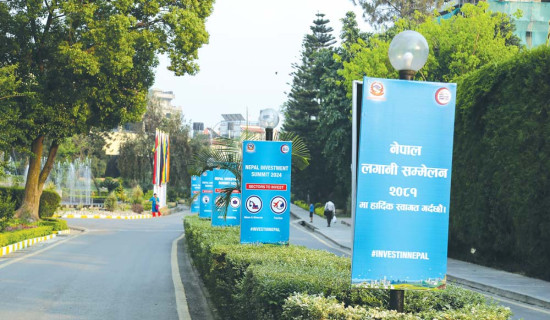- Tuesday, 30 April 2024
Why Panchanga Is Important For Hindus
Christmas is always on December 25. However, Dashain is not always on the fixed date. Last year, it was on Asoj 19 (October 5), and this year it was on Kartik 7 (October 24). Christmas is always on 25th December because the Christian calendar is based on solar months and date for Dashain varies because Hindu festivals uses lunar months. Christian calendar, also called Western calendar or Gregorian calendar, is basically a solar calendar. Not just among the Hindus, lunar calendar is also popular in other cultures as well, for example Islamic calendar called Hijri is also a lunar calendar.
Even though, most of the Hindu festivals are based on lunar calendar, Hindu calendar also incorporates solar calendar and some Hindu festivals are based on solar calendar, for instance, Karkat Sankrinti, Makar Sankrinti, etc. Hindu calendar is called Panchanga, which incorporates solar calendar as well as lunar calendar. Panchangam or Panchanga is a Hindu calendar and almanac based on Hindu astrology or Vedic astrology. Panchanga is a system of timekeeping that not only tracks, days, weeks, months, and years, but also celestial movements (movements of planets) and celestial incidents like solar and lunar eclipses, as well as forecasting weather.
Hindus use Panchanga not only to determine date and time but also to find about their festivals, learn about auspicious time for important events like weddings, buying properties, etc. Panchangas are widely used in India and Nepal to determine horoscope, auspicious time, as well as to make astrological calculations. In these countries, Panchangas are published by astrologers, societies, academies, and universities.
Mathematical calculations
Nepal government even has a governing body for Panchanga, called Panchanga Nirnayak Samiti, and every publisher of Panchanga has to get approval from the body in order to publish Panchanga. Panchanga is so accurate and scientific that it can calculate the exact date and time of celestial phenomena like solar eclipse 100 years advance. Making of Panchnga requires mathematical calculations, geometry as well as astronomy. Calculations and tabulations are based on the formulas written by ancient sages of Vedic astrology.
In the beginning, Panchanga was generated by using the theories and formulas mentioned in Grahalaghava and Surya Siddhanta. Calculations in Panchanga provide the positions of planets (popularly called grahas) and constellations (nakshatras) as they are observed in the sky. The principles of Panchanga are based on the 5000 years old Vedic tradition.
The word Panchanga is made from two Sanskrit words ‘Pancha’ (which means five) and ‘Anga’ (which means limbs). Thus, Panchanga includes five major attributes viz.: tithi, nakshatra, rasi, yoga, and karana.
These attributes are based on the movement of the moon. Panchanga is so comprehensive that you can find everything from English date, Bikram Sambat date, lunar day, to planetary position, planetary movements, celestial phenomena like eclipse, zodiac, horoscope, etc. Tithi is the lunar day (elongation of the moon), or the angular relationship between sun and moon. One tithi is 12 degree difference between the moon and sun.
Likewise, nakshatra is the constellation where the moon is located for an observer on the earth. There are 27 nakshatra, one nakshatra is 13 degrees and 20 minutes, the 27 nakshatra is 360 degrees. rashis are the zodaic symbols, there are 12 rashis. Some Hindu astrologer includes “var” (solar days, of 7 days of the week) instead of rashis as one of the attributes of Panchanga.
Yoga, which is different from yoga as in Patanjali yoga, literally means the sum of two or more things. Thus, yoga is the angular relationship between the sun and the moon. There are 27 yogas in 360 degree and one yoga is 13 degrees and 20 minutes. Karana is half of a tithi, where one karana is six degree difference between the moon and the sun. Apart from these five attributes, Panchanga also includes samvatsara (the cycle of 60 years), barsha (year), and masa (month). Barsha begins when the sun enters Aries and ends when the sun is in Pisces. Thus, barsha in Hindu Panchanga is based on the solar calendar of year and months.
Auspicious time
Tithi is a very important aspect of Panchanga, which means that Panchanga also uses a lunar calendar (as explained above, the tithi is a lunar day). There are 30 tithis, where the bright half has 15 tithis and dark half has 15 tithis. An auspicious time or muhurtha is also very important aspect of Panchanga, muhurtha is based on tithi, karana and yoga. The basic purpose of Panchanga is to give exact details of time (auspicious time or muhurtha), day (tithi, karan), festivals, celestial phenomena, and weather. Currently, numerous individuals and institutions publish Panchanga in Nepal. Some of the popular Panchangas in Nepal are Surya Panchanga, Toyanath Panchanga, Akashdarshan Panchanga, etc.
The modern-day Panchanga in India is based on the Indian national calendar published in 1957. Since the actual astronomical events did not tally with the principles in these scriptures, the Government of India formed a committee to make Panchanga calculations based on actual astronomical events. The currently used western calendar was revised in 1582 by Pope Gregory to tally with the actual seasons. In the last couple of years, astrologers in Nepal are also discussing about revising the Panchanga so that it incorporates actual celestial phenomena.
(Ghimire is freelance writer based in Dang.)

















